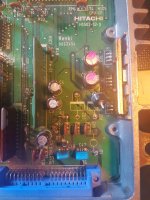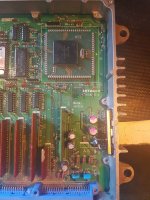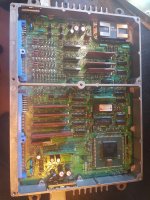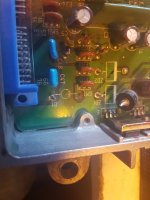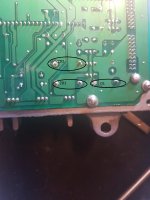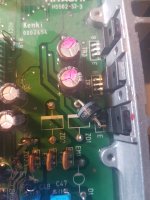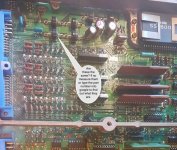The little'un looks like a glass passivated type which are often high speed devices such as used in SMPS circuits. Probably 1 to 2 amps continuous rating but could be anything up to 1kv in voltage (could be... doesn't mean it is though)
No idea on the other one besides it looking big and chunky and so perhaps quite high current.
You need to know the voltages around these parts before you can decide on replacements.
No idea on the other one besides it looking big and chunky and so perhaps quite high current.
You need to know the voltages around these parts before you can decide on replacements.
I have just asked the customer what voltage is coming into this. I'll get back to this as soon as possible.
I posted some more pictures. ZD1 and ZD2 are the large black diodes and are connected in series.
D1 is the blue one.
I posted some more pictures. ZD1 and ZD2 are the large black diodes and are connected in series.
D1 is the blue one.
Attachments
well, if they are labeled as zd, hey are likely zener diodes
what you need to figure out is their zener voltage
How to Test the Voltage of a Zener Diode - YouTube
what you need to figure out is their zener voltage
How to Test the Voltage of a Zener Diode - YouTube
I would agree with adason on that, ZD is most likely Zener.
Are they across a 'rail'?
They seem to be across that electrolytic directly above the diode/s. If so then they are Zener's or some other form of transient protection/overvoltage device. That means for test purpose only you may feel it valid to power the board up with these removed, obviously at your own (and the boards) risk.
The other diode looks like it could be used as some form of rectifier. Just fit something generic but fast in there.
A UF5408 could be an option (note this is not the same as the common 1N5408)
MUR460RLG is another. There are many that fit the high voltage high speed high current criteria.
Are they across a 'rail'?
They seem to be across that electrolytic directly above the diode/s. If so then they are Zener's or some other form of transient protection/overvoltage device. That means for test purpose only you may feel it valid to power the board up with these removed, obviously at your own (and the boards) risk.
The other diode looks like it could be used as some form of rectifier. Just fit something generic but fast in there.
A UF5408 could be an option (note this is not the same as the common 1N5408)
MUR460RLG is another. There are many that fit the high voltage high speed high current criteria.
Just curious what symptom or measurement or test made you remove those diodes.I do not know if I can place this question here, but for repair of an excavator control I am looking for the values and the type of diodes used. I can't find anything about it. I hope you can help me further.
those usually don't fail. the transistor is likely dead.
what is the board from?
another place to look is the 5v power supply and filter caps that power the logic.
what is the board from?
another place to look is the 5v power supply and filter caps that power the logic.
JMFahey, because they are short.
Customer specifies that the unit operates on a voltage of 24 to 27 volts. From this you could conclude that it is a zener of 27V. However, they are connected in series so that would not be true. Capacitors arround are 50V
Customer specifies that the unit operates on a voltage of 24 to 27 volts. From this you could conclude that it is a zener of 27V. However, they are connected in series so that would not be true. Capacitors arround are 50V
Last edited:
Thanks.
Well, they might be 12V or so Zeners in series.
If you want to share power in Zener diodes, you put them in series, not in parallel.
Where/what are they connected to?
As in: IF those transistors just by them drive some kinf of motor or solenoid (very inductive loads); they might be some kind of overvoltage protection.
What do those transistors do?
What are they connected to?
Are they alive?
Personally, lacking a schematic and/or service manual, and maybe not being a specialized service guy who repeirs these things all week long, am not sure about possibilities of success.
It is a COMPLEX circuit, we don´t know what kind of firm/software is loaded on that microprocessor ... bet even Factory does full board replacement.
Like on washing machines, HVAC, freezers, microwave ovens and tons other stuff.
Well, they might be 12V or so Zeners in series.
If you want to share power in Zener diodes, you put them in series, not in parallel.
Where/what are they connected to?
As in: IF those transistors just by them drive some kinf of motor or solenoid (very inductive loads); they might be some kind of overvoltage protection.
What do those transistors do?
What are they connected to?
Are they alive?
Personally, lacking a schematic and/or service manual, and maybe not being a specialized service guy who repeirs these things all week long, am not sure about possibilities of success.
It is a COMPLEX circuit, we don´t know what kind of firm/software is loaded on that microprocessor ... bet even Factory does full board replacement.
Like on washing machines, HVAC, freezers, microwave ovens and tons other stuff.
Last edited:
- Home
- Design & Build
- Parts
- What kind of diodes are this?

